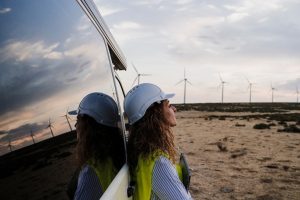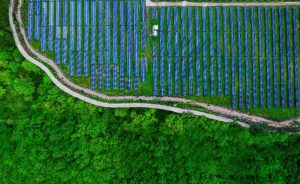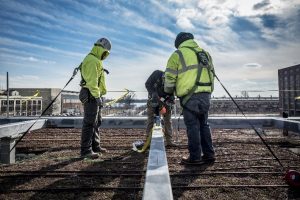Energy sovereignty represents more than just control over energy generation and distribution—it embodies the fundamental right of self-determination and autonomy. Yet there’s a curious paradox in how we often discuss energy sovereignty, particularly in the context of tribal nations: the language sometimes suggests it’s something that must be granted rather than claimed. This perspective misses the essential nature of sovereignty itself.
 Understanding Energy Sovereignty as a Dynamic Concept
Understanding Energy Sovereignty as a Dynamic Concept
Energy sovereignty, at its core, represents the right and ability of communities to make their own decisions about energy systems. This includes choices about how energy is generated, distributed, and utilized within their territories. However, it’s crucial to understand that sovereignty isn’t binary—it exists on a spectrum, with communities exercising varying degrees of control over their energy systems.
At one end of this spectrum, we find communities with minimal control over their energy decisions, typically receiving power from external utilities with little say in pricing, source, or distribution. At the other end, we see full energy sovereignty, where communities maintain complete authority over their energy infrastructure, from generation to distribution, including technological choices and pricing structures.
The space between these extremes is where most communities currently operate, with different levels of influence and control over their energy systems. Some might have agreements with external utilities but maintain certain rights over distribution. Others might generate their own power but rely on external grid connections for backup or excess power sales.
 The Path To Active Energy Sovereignty
The Path To Active Energy Sovereignty
Moving along this spectrum toward greater energy sovereignty requires active engagement rather than passive waiting. Communities must take deliberate steps to build their capacity for energy self-determination. Here’s how this journey typically unfolds:
1. Assessment and Planning
Communities must first understand their current position on the sovereignty spectrum and identify their desired destination. This involves evaluating existing energy infrastructure, consumption patterns, and available resources. The assessment phase should also include a clear-eyed look at technical capabilities, financial resources, and potential partnerships.
2. Building Technical and Economic Capacity
Achieving energy sovereignty requires developing both technical expertise and economic resources. This might involve training community members in energy system management, establishing relationships with technical advisors, and creating financial strategies to support energy infrastructure development.
3. Creating Governance Structures
Communities need to establish or strengthen governance mechanisms for managing energy systems. This includes developing policies, procedures, and decision-making frameworks that reflect community values and priorities. These structures should be designed to ensure accountability and meaningful community participation in energy decisions.
4. Implementing Initial Projects
Starting with smaller, manageable projects allows communities to build experience and confidence. This might begin with energy efficiency initiatives or small-scale renewable energy projects, gradually expanding to more comprehensive energy management systems.
5. Utility Formation and Management
One of the most direct paths to energy sovereignty involves establishing Tribally owned utilities. This approach allows communities to make decisions about energy sourcing, pricing, and distribution. Some communities might start by negotiating better terms with existing utilities while building capacity to manage their own systems. Another strategy is to take on administrative tasks like monthly meter reading, billing, and dispute resolution.
6. Resource Assessment and Development
Communities must thoroughly understand their energy resources and potential. This includes evaluating renewable energy potential, understanding current energy usage patterns, and identifying opportunities for efficiency improvements. This knowledge forms the foundation for strategic energy planning.
7. Partnership Building
While the goal is sovereignty, strategic partnerships can help communities build capacity and transition to greater control. These might include relationships with technical advisors, funding agencies, or other communities that have successfully implemented energy sovereignty initiatives.
8. Policy and Regulatory Engagement
Communities must actively engage with policy and regulatory frameworks that affect their energy systems. This includes advocating for policies that support energy sovereignty and working to remove regulatory barriers that might impede progress.
 Strategic Economic Sequencing
Strategic Economic Sequencing
One of the most effective strategies for building energy sovereignty involves the careful economic sequencing of initiatives. The key is to prioritize outcomes that generate revenue and avoid excess expenses that can quickly build up. Look to create financial sustainability before taking on more complex aspects of energy management.
This approach typically begins with projects that have immediate financial benefits, such as:
- Installing solar PV systems to reduce purchased power costs
- Developing generation projects that can sell power to existing utilities
- Implementing energy efficiency measures that provide immediate cost savings
The strategy deliberately postpones activities that create significant ongoing costs, such as:
- Building large operational teams
- Taking on complex regulatory compliance responsibilities
- Developing comprehensive utility infrastructure
This sequencing allows communities to build financial strength gradually. The revenue and savings from initial projects can then support more ambitious steps toward sovereignty, including hiring necessary staff and developing regulatory compliance capabilities. This approach creates a sustainable foundation for long-term energy sovereignty, rather than trying to build everything at once and potentially overwhelming community resources.
 Moving Forward: The Active Path to Energy Sovereignty
Moving Forward: The Active Path to Energy Sovereignty
Energy sovereignty isn’t something to be waited for — it’s something to be actively pursued and claimed. Communities that have successfully increased their energy sovereignty have done so through deliberate action, careful planning, and persistent effort.
The journey toward energy sovereignty requires a clear vision, committed leadership, and community engagement. It involves building technical capacity, establishing governance structures, and developing partnerships.
As we continue to face global energy challenges and transition toward more sustainable systems, the importance of energy sovereignty becomes increasingly clear. Tribal communities that take active steps toward energy sovereignty position themselves to better serve their members, protect their resources, and shape their energy future.
The path to energy sovereignty may be challenging, but it’s through active engagement and deliberate steps forward that communities can move along the spectrum toward greater control over their energy systems. The question isn’t whether sovereignty will be granted, but rather how communities will claim and exercise their inherent right to energy self-determination.
 Taking the Next Step: Partner with Experience
Taking the Next Step: Partner with Experience
The journey toward energy sovereignty requires both vision and practical expertise. ProtoGen’s staff brings over 28 years of industry experience to this critical work, including more than five years of dedicated partnership with tribal nations to transform energy sovereignty from concept to reality. Our track record includes active partnerships with three tribal communities at various stages of utility planning and implementation, giving us deep insight into the unique challenges and opportunities each nation faces.
We understand that every tribe’s path to energy sovereignty is unique, shaped by their specific needs, resources, and aspirations. That’s why we begin with listening. ProtoGen offers no-cost initial consultations to understand your nation’s goals and evaluate your current situation. This consultation provides a foundation for developing a customized approach that aligns with your community’s vision for energy sovereignty.
Whether you’re in the early stages of exploring energy sovereignty or ready to take concrete steps toward implementation, we’re here to help guide your journey. Contact ProtoGen today to schedule your no-cost consultation and take the first step toward greater energy self-determination.
Contact us at Contact@ProtoGen.com to begin the conversation about your nation’s energy future.

 Understanding Energy Sovereignty as a Dynamic Concept
Understanding Energy Sovereignty as a Dynamic Concept The Path To Active Energy Sovereignty
The Path To Active Energy Sovereignty Strategic Economic Sequencing
Strategic Economic Sequencing Moving Forward: The Active Path to Energy Sovereignty
Moving Forward: The Active Path to Energy Sovereignty Taking the Next Step: Partner with Experience
Taking the Next Step: Partner with Experience